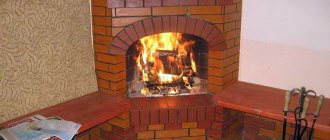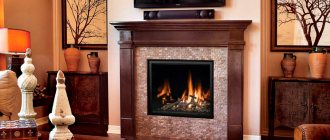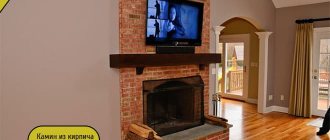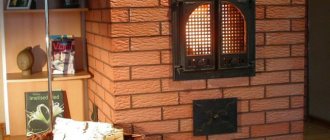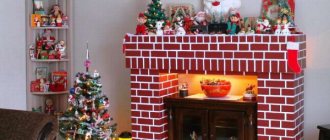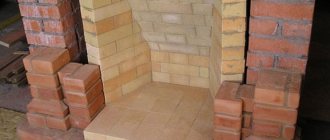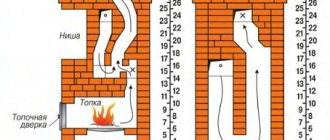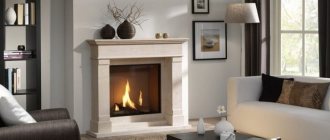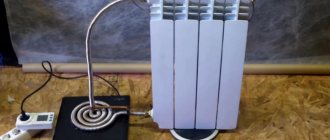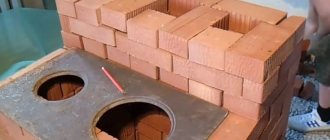Potbelly stoves, fireplace stoves, country stoves, fireplace heaters - under all these names lies a compact mobile device, which is based on a metal single-chamber firebox with a glazed door. How to choose this heating device and what should be taken into account when installing it?
So, a modern fireplace stove is a firebox (steel or cast iron), equipped with a metal glazed door and (as an option) a casing made of metal, ceramic or stone. This is a relatively small device, the height of which varies from 60 to 175 cm, width - from 45 to 60 cm, and depth - from 40 to 50 cm. Such devices are relatively lightweight (on average 120-200 kg), mobile and easy to install , become a real salvation when the heating system, for one reason or another, is not working efficiently enough, and installing a large stationary stove with all the construction “joys” in the form of opening floors, pouring the foundation, etc. is not possible.
The fireplace stove can be installed in any room, both one under construction and one that has been in use for a long time, and if you move, you can simply disassemble it and take it with you. But along with the pros, there are also cons.
Fireplace stoves are quite voracious and have low heat capacity, which is due to the small size of the combustion chamber. In other words, once the wood burns, it cools down very quickly. A ceramic or stone casing helps slow down this process, but it increases both the weight and cost of the product. In addition, a fireplace stove can only heat one room. True, there are models with a water heat exchanger and the ability to distribute warm air to adjacent rooms.
One of the main advantages of a fireplace stove is that it begins to heat up within 15–20 minutes. after ignition
Nevertheless, the popularity of fireplace stoves is very high, and demand, as we know, creates supply. The choice of devices of this kind is immensely wide; they are produced both here and abroad. The price range for products is quite significant: a simple Russian-made model can be purchased for 9,000 rubles, and an elite European one will cost 150,000 rubles. and more.
Pros of a metal fireplace
Many people believe that the first people to make a metal fireplace with their own hands were in Japan. However, those who are familiar with Russian “potbelly stoves” have doubts.
In any case, this type is widely used in our country. The product can be made with any design, in any size and for different rooms. Hence the popularity.
It also does not require installation on a special foundation, so you can think about installing it even when the repair is already completed. Since it is quite mobile, it can be moved to different places.
This fireplace heats up well, so the room becomes warmer faster. Metal conducts heat well, so the room can heat up instantly. But just as well and quickly as the material heats up, it cools just as quickly. This is its disadvantage.
However, it can be easily eliminated. Very often, metal fireplaces are lined with brick on the outside. This finish accumulates heat, so the structure does not cool down longer.
Interesting solutions in interior design from the designer
Metal fireplaces look especially good in industrial-style apartments, as well as in rustic interiors.
Types of metal fireplaces
The price of a metal fireplace can vary depending on many factors, including its type. Its varieties are not so wide, but everyone can choose a model to suit their needs and room characteristics:
- Straight central;
- Angular;
- Suspended structure;
- Built-in;
- Wall-mounted.
A corner metal fireplace has similar properties to the straight type. Therefore, they have a number of advantages:
- A simple design that can be easily made even by yourself;
- The project itself and materials are not that expensive;
- The chimney is made straight, so the draft is excellent. Even damp wood can burn;
- Compared to brick, it does not weigh as much, the room heats up quickly.
This option is suitable not only for a house, apartment, but also for a dacha.
Selection of materials and surface structure
A metal fireplace stove can be made from:
| Material | Peculiarities |
| Steel | A metal fireplace stove can be made of steel. This material has an average and affordable price range. The coating is distinguished by its light weight, easy maintenance and fast heating. If necessary, you can line the prepared steel surface with any fireproof and environmentally friendly materials. |
| Cast iron | Cast iron has a lot of weight and therefore it takes much more time to warm up such an installation. The coating is distinguished by its durability, strength, and reliability. Such stoves continue to heat the premises, release and distribute heat for some time after the end of the fire, which is very convenient and practical. |
| Copper | Metal stoves and fireplaces made of copper are rarely made due to the high cost of this material. Certain elements, inserts, decor, and decorations are mainly made from copper. |
Interesting to know: hearths and
metal stoves and fireplaces can have a different surface (smooth, matte, corrugated, shiny, with embossing or decorative stamps).
To get acquainted with various purchased and home-made models, we recommend viewing the photos located in this article.
Where to put the fireplace
Drawings of metal fireplaces must be created in accordance with the installation location. Of course, it is better that the room is of normal size, not too small.
- Because it will work smoothly only when there is a lot of air supplied to create thrust.
- If the fireplace is not lit, at this time it can be used as an exhaust hood, the air will circulate constantly.
- Of course, the metal version is smaller than the brick one, but still weighs about 100 kg or even more.
- Therefore, you should take care of the place where it will be installed, first strengthening the structure somehow.
It is better to immediately take care of fire safety. To do this, the area around the fireplace is insulated with special material. Tin sheet or asbestos will do. This applies not only to floorboards, but also to walls.
What to look for when choosing?
Let's start with the fact that, no matter how perfect a fireplace stove is, you shouldn't rely on it as the main heating device. A potbelly stove is not able to heat a house; its task is to properly heat one room. So you need to choose a model based on the area of this room.
True, the figures given in the documentation by foreign companies should be approached with a certain degree of skepticism. Perhaps a tiny stove will be able to provide heat to a room of 50 m², but only in a mild European climate. Most fireplace stoves come from France and Italy, and experiments to determine their effectiveness were carried out there. Needless to say, our winters are much harsher. Therefore, it is wiser to focus on the declared power of the product.
Sometimes during the first firing of the fireplace stove an unpleasant odor appears. This burns through the metal dust. But you shouldn’t be afraid of this - after a few days of use, the smell of scale disappears
There is a simple formula: 1 kW per 10 m² with a ceiling height of 2.7-2.8 m. But these are optimistic figures, implying that the device will work in a well-insulated house. If the building suffers some heat loss during the cold season, it is better to proceed at a rate of 1 kW per 7 m², and when things are really bad with thermal insulation, then 1 kW per 5 m².
Another point to pay attention to is the size of the firebox.
The area of its opening must correspond to the size of the heated room in a proportion of at least 1:75. In general, the larger the chamber, the more efficient the heating. Small ones are inconvenient because you have to heat them with short logs - they burn quickly, which means you will need to add firewood every 3-4 hours.
It is strictly forbidden to burn fireplace stoves with coal. It generates a huge amount of heat and the glass door may not withstand the heat
How to decorate a fireplace
A simple metal fireplace will not look good on its own; it will definitely need finishing, at least minimally. You can simply coat it on top with fireproof paint, giving it any color. This is the advantage of this design, because it can be installed in any room without thinking about style and color.
It is better if the shade is dark. Because according to the laws of physics, these colors emit more energy than light ones. This is perfect for a structure like a fireplace because heat is very important.
- If you decide to finish the fireplace, then you should also use materials that are fire resistant.
- Ceramics, artificial stone, as well as natural finishing in the form of natural materials are suitable for this.
- Metal tends to expand when exposed to heat, so be sure to leave a little more space between the tiles.
If you decide to make a fireplace with your own hands, you can realize any idea you want. The main thing is to outline a plan in advance.
Ready-made metal stoves
If you can’t make a stove to heat your home or cottage with your own hands, buy a ready-made device that will have no less productivity and functionality. The most popular manufacturers that produce wood stoves for individual use:
- Traforart - fireplaces of this production are equipped with elements that supply air from outside, as well as a secondary combustion function;
New TraforArt products
- Boley - produces models in both classic and high-tech styles. Many units are equipped with glass doors. The Boley stove can be lined with marble, granite, and various metal alloys; Fireplace Boley Speciale Glashaard
- Cheminees Philippe is a European manufacturer that produces fireplaces ranging from the simplest to the most interesting shapes in the avant-garde style; Wide firebox from Cheminees Philippe
- Fugar – produces metal stoves in the mid-price category. The most popular are hanging models or those with a central location; Fireplace brand Fugar
- Meta - have a fairly affordable price. The Meta oven is equipped with a glass-ceramic door, a spacious firebox, and some models have a hob. Meta and fireplace stoves
Wood-burning stoves made of metal are an excellent solution for heating residential premises, even despite some disadvantages.
[ads-pc-2][ads-mob-2]
How to make it yourself
To make a fireplace with your own hands, you do not need any special skills or abilities. The manufacturing instructions will help you make it yourself:
- Take metal corners. With their help it will be possible to make a frame in the form of a rectangle on legs. This will serve as the basis for the future design. Now the legs need to be secured so that they do not wobble on the floor and are stable;
- Metal sheets need to be connected to form a box. This is the future preparation for firewood; it is in it that fuel will be loaded. To make the firebox more productive, use two layers for it. Doors are also attached to it;
- After the structure is assembled and everything is connected for the firebox, you can make a chimney. Both round blocks and the same pipes are suitable. They can be joined together and the seams can be sealed. If you need a curved chimney, then a metal elbow is suitable for such a connection. If there are hanging elements, they are secured using clamps or brackets;
- In order for the fireplace to be ready for use and at the same time comply with fire safety standards, it is necessary to insulate the components that pass through the chimney. Cardboard or glass wool is suitable for this;
The back wall and the surrounding flooring are also insulated with fire-resistant material.
The fireplace is assembled. All that remains is to move the structure to a place where it will be provided with normal air flow.
Fireplace inserts made of cast iron and steel: advantages and disadvantages and lining features
Route User FORUMHOUSE
I want to install a wall-corner fireplace with a glass-covered firebox in my house for decorative and aesthetic purposes. Heating qualities are secondary. The primary ones are beauty, reliability, ease of installation and low maintenance. I formed for myself the basic requirements for a fireplace. This:
- High quality manufacturing of the firebox so that nothing cracks during use of the fireplace.
- Acceptable price.
- The fireplace should not smoke or burn out air.
- The system must be secure.
- The glass should not be covered with soot.
But most importantly, I still haven’t decided which material is better for the fireplace insert: steel or cast iron?
Traditionally, cast iron is used to create fireplaces and other heating appliances. Fans of this material give the following arguments in favor:
- Cast iron does not deform during prolonged heating, is heat-resistant and can withstand quick/sharp start-up when operating the fireplace.
- Cast iron has good heat capacity.
- Cast iron looks beautiful in the interior.
Andrey Kozyrev
Indeed, the high heat resistance and attractive appearance of cast iron make it possible to successfully use this material for the manufacture of fireplace inserts. But cast iron has a number of features that you need to know about in order to make an informed choice of firebox material.
Disadvantages of cast iron:
- Fragility. This feature must be taken into account when operating the fireplace. Cast iron can crack if struck sharply, for example by a poker or a log carelessly thrown into the firebox.
- The complexity of welding cast iron parts. Cast iron fireplace inserts and stoves are assembled from fairly flat panels, using screw connections, and the joints are sealed with modern heat-resistant materials.
- There are restrictions on the size of the firebox and the impossibility of repairing the fireplace body by straightening, etc.
Let's move on to the advantages of steel fireplace inserts:
- Steel is a high-tech material. It lends itself well to metalworking, repair, and is not afraid of impacts.
This improves the consumer properties of the fireplace.
In contrast to cast iron products, steel is easily welded, which ensures a significantly higher gas tightness (tightness) of the fireplace.
- Steel is ductile, so the size of modern fireplace inserts has increased significantly.
The width of the steel firebox of 1200 or 1500 mm has long become the standard. While for a cast iron firebox a width of 1100 mm is the technological limit. In fact, the size of a steel firebox is unlimited (as a rule, fireboxes over one and a half meters wide are made to order).
The disadvantage of steel is the low heat resistance of its budget grades.
This feature of the material can be corrected by lining the fireplace insert with refractory materials . For example, some manufacturers use fireclay or cast iron as a refractory lining for a steel firebox.
When combining materials, the steel structure of the firebox bears all the mechanical loads, and cast iron or fireclay bears the temperature loads.
Andrey Kozyrev
For thermal protection of a steel fireplace insert, you can use cast fireclay (thermoconcrete). This is a modern material with a heat resistance of 1320 °C. Thermoconcrete has a very smooth and attractive surface, which promotes self-cleaning of the internal surface of the firebox. Two colors are available - black and white. The white lining harmonizes well with the light finish of the fireplace. Soot is not visible on the black lining (although soot on light-colored lining burns out as the fireplace heats up, i.e., it cleans itself) and its color scheme resembles classic black cast iron.
Security measures
Do not forget that a fireplace is, first of all, a source of increased danger if you do not look after it. Any spark that accidentally jumps out of it can cause a fire.
Therefore, there are certain safety precautions that must be observed:
- The walls of the fireplace get very hot, so it is contraindicated to place it in children's rooms. That is why there are requirements for insulating walls and floors;
- The chimney, through which combustion products must escape, is made with an outlet through the roof to the street. That is why it is important to choose the right place so that there are no problems with the removal of parts.
copper
Fireplaces made of non-ferrous metal are more expensive than cast iron or steel. But they allow you to bring warm copper shades into the interior. A bronze fireplace is less prone to corrosion and rust. And the plasticity of the material makes it possible to make parts of any complexity and filigree from it, which allows you to make the fireplace a real work of art.
According to their purpose, metal fireplaces are divided into the following groups:
- heating devices. This is the most common group of fireplaces, performing only the main function - heating the room;
- stoves-fireplaces. The upper surface of such ovens is the hob. This way you can even heat food on small fireplaces or, for example, boil a kettle;
- grill It turns out that this is also one of the types of metal fireplaces. The main function in such open-top structures is to cook food over coals or wood with low combustion;
- decorative fireplaces. They do not provide much heat, but in metal decorative fireplaces you can watch the play of live fire. There are very compact models of decorative fireplaces, suitable for installation in the smallest niches.
Photo of a metal fireplace
Installation
To install a metal stove in a bathhouse, you need to start by preparing a site for it. Such a stove weighs less than a brick stove; it does not require a foundation, but it has a greater fire hazard due to the high temperatures reached due to prolonged burning of wood.
The site for installing the furnace is prepared at least twice as large as the area occupied by the furnace itself, and consists of several layers located from bottom to top:
- asbestos coating;
- stainless steel;
- six-centimeter heat-resistant brick;
There is another option:
- we dig a shallow pit, maintaining the same proportion in terms of area;
- pour sand, crushed stone, compact it;
- fill it with cement mortar and wait for it to harden;
- We spread roofing felt as thermal insulation;
- We check the plane with a level, it is better to make a slight slope towards the drain;
- lay out two rows of red bricks.
To prevent fire, the stove should be placed no closer than one meter from walls and easily flammable objects. The walls around the stove are plastered, lined with bricks, sheathed with sheets of iron or mineralite, and a firewood storage area is separated. If the firebox is removed from the steam room, the opening is also protected from fire by non-combustible materials.
The location for creating the hole for installing the chimney must be provided during the construction of the bathhouse. Creating elbows in the chimney will cause soot to be deposited in such parts of the chimney, which will worsen the draft in the stove. If it is impossible to eliminate such places in the chimney, consider dismantling this area to clean it.
The chimney channel should be made of a double wall sandwich filled with basalt wool. As insulation, you can use a square water tank, which is installed in the ceiling.
Having installed the stove in place, we fill the heater with stones of basalt, river or sea pebbles, gabbro-diabase, soapstone, porphyriate, dunite, white quartz, crimson quartzite. It is better to choose flat stones and place them on the edge in the heater. Do not use stones with red veins or inclusions (this is iron), it is harmful to health when oxidized.
Design Features
The main purpose of a wood-burning sauna stove with a water tank is to warm up the steam room well and maintain an acceptable room temperature for a long time. To get maximum results, the design is equipped with the following elements:
- Firebox
. The main purpose of this structural part is to be able to burn fuel to generate thermal energy. A grate is installed here, which has a certain angle of inclination towards the door. Due to this, combustion products are moved to a convenient place so that they can be easily removed. - Kamenka
. It consists of a large number of stones that gain sufficient temperature due to the combustion of fuel. Cobblestones transfer thermal energy to the room. Hot stones produce steam when water is poured over them. - Heat exchanger
. Most often they are a large tank of water. As wood burns, the liquid heats up. - Chimney
. It can be made of bricks or consist of a solid metal pipe. The main purpose is the removal of gases and combustion products. Due to this design feature, wood-burning sauna stoves with a water tank have low efficiency. - Ash pan
. The part of the structure that is located below the firebox. Solid combustion products come here. - Door with passage tunnel
. A similar structural element of a sauna stove with a heat exchanger is provided if lighting and maintaining combustion is carried out from a dressing room or other room.
Decorative finishing
A stove in a bathhouse is not only a source of heat, steam, and increased danger, it can also be a decoration for the room.
If you only care about the safety of the stove, then it is enough to paint it with modern paint to protect the metal from corrosion. The use of heat-resistant enamel based on silicone paints is no different from conventional enamels, but protects metal at temperatures up to +800 degrees. The metal is degreased and then paint is applied. After the first layer has dried, the next layer is applied. It is recommended to paint those metal elements that will be covered with brick and insulation.
The decoration of the stove in the bathhouse can perform a purely decorative function in the form of forged decorations and additional decorative elements of the stove itself. You can use heat-resistant paints of various colors with an antique effect. Decoration can also be used to eliminate the increased danger of a sauna stove.
The stove can be lined with red brick masonry (we have already considered this method), but the masonry on the sides can be decorative, in the form of a grid. On the firebox side, the stove can be covered with a screen made of forged elements or simply with a beautiful mesh fixed in the frame.
It can be covered with a beautiful casing, also covered with heat-resistant paint, in the color you like.
A stove lined with heat-resistant stone will look impressive; this will not only give a noble look to your product, but will also improve the quality of the stove itself.
The decorative decoration of your bathhouse stove depends only on your desire, taste and wallet size.
Partitions
The interior of the kitchen and living room begins to be thought out from the junction of the two zones.
- Here are some of the ways and objects that delimit space:
- installation of a bar counter;
- kitchen island;
- big table;
- installation of a low partition.
Designers advise installing a wide counter, since you can sit at it like at a regular table, and high chairs are quite suitable for the whole family.
However, in small rooms (16 sq m), narrow counters are installed. Kitchen islands are convenient to use, but are only suitable for large kitchen-dining rooms (25 sq m or 30 sq m). Capital low partitions are installed only if it has been decided in advance what they will be used for (for example, as a TV stand).
Other tips
The living room with the kitchen can be combined and decorated with various shortcomings
It is important to calculate and anticipate everything in advance. Decorators and craftsmen share tips that will help avoid problems during repairs and furnishings:
The result depends on how detailed the project is drawn up. Oddly enough, it is worth taking into account the growth of loved ones and relatives. It is also recommended to calculate the approximate number of possible guests. You can get rid of food smells by installing a strong hood or ventilation system.
Small models are more suitable for housewives who do little cooking. If you plan to have a sleeping place in the living room, then it is important that the ringing of appliances and other kitchen utensils is not heard. Silent dishwashers and other appliances will come in handy.
In addition, you can install a sliding door and install a soundproof partition. If there is sensitivity to ultraviolet radiation, the owners hang thick curtains made of light-proof fabric. If household appliances do not match the direction of the interior, they are hidden behind furniture or put away in kitchen cabinets. When installing luminaires and lamps, they are guided by several criteria
It is important that the light falls evenly throughout the entire space. Especially bright lighting is preferable in the kitchen area and where the dining table is installed
In the living room, designers create a subdued atmosphere using wall sconces and table lamps. Multi-level stretch ceilings with LED strip also look good in this room. Moisture-resistant finishing materials are more durable and easy to clean. Thus, they retain their appearance for a long time.
The kitchen combined with the living room combines:
- personal tastes of the owners;
- reliable finishing materials;
- current design ideas;
- convenience;
- trends. The best photos of kitchen living room design

